Efficient ranching: Smaller cows build big returns in USA
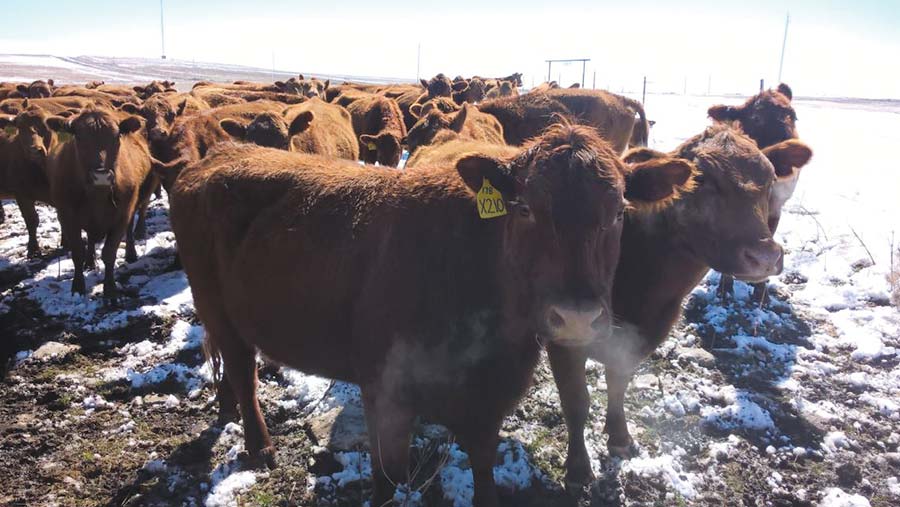
Bigger is not better at the Mushrush family ranch, Kansas, where small-to-moderate Red Angus cows are challenged to wean a calf at a minimum of 50% of cow weight in 160 days.
This focus on function and efficiency is a key profit driver in low-input systems and is the reason Mushrush Red Angus genetics are gaining popularity across the USA.
The ranch has 700 registered pure-bred cattle and 550 commercial heifers across 4,046ha of tallgrass prairie, supplying genetics into the US cattle industry and beef through processors and the family’s own brand, Mushrush Family Meats, which was launched early in 2015.
See also: Beef farmer sees 69% rise in profit with rotational grazing
Registered cows in both spring (450-head) and autumn (250-head) herds are bred and sold annually. Meanwhile, Mushrush-bred progeny is bought back off other ranchers and finished.
Combined with a drive for low birth weights and easy-fleshing calves, the Mushrush herd is producing functional, maternal cattle that can perform in the extensive and challenging rangeland beef systems of the central states.
“Efficiency is one thing we focus on,” says Daniel Mushrush, a third-generation rancher who farms alongside parents Joe and Connie and the rest of the family in the Flint Hills in eastern Kansas.
“Anything weaning 40-45% of its weight is usually a cull cow here.”
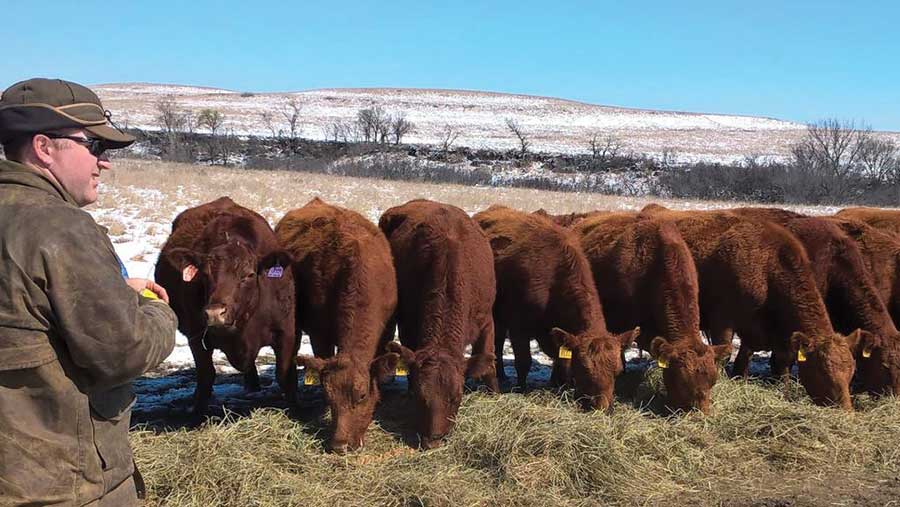
Daniel Mushrush believes small cows and low birth weights work best
Exceptional cows wean 60% of their weight by 160 days, with one star performer last year weighing 453kg and weaning a 294kg calf.
“If she does it again this fall and makes it a trend we will flush her and try to get many more calves out of her,” adds Daniel, who recorded a herd average mature weight of 553kg last year.
Supplementing cows
Supplementation and cow costs can vary hugely year to year, according to the quality, abundance and price of grazing.
This year, the main feeding supplementation is coming from protein nuts at £140/t and bought-in hay at £33/t. General feed costs are budgeted at $800 (£550) a head for the autumn- and spring-calving herd of 700 pedigree cows.
“Hay-wise prices are really low – the same hay was $200/t (£130/t) during the drought,” explains Daniel. “But at $50/t (£34/t) we can graze the land harder and not worry about making hay this year.”
Cow feeding timeline
|
Supplement |
Timing |
Quantity |
Source |
|
Concentrate 20% CP |
October into winter |
1.8-2.2kg a head a day |
Sunflower meal, soybean meal, corn distiller’s grain or wheat midds |
|
Concentrate 40% CP |
New Year |
0.9kg a head a day |
Sunflower meal, soybean meal, corn distiller’s grain or wheat midds |
|
Hay |
November/December and when snow covers grass in the New Year |
6.8-9kg a head a day |
Cool season brome grass or oats/rye annual |
Flexible weaning
Spring and autumn calving targets a 32-36kg birth weight to allow unassisted outdoor calving at or below 5% mortality, which is considered an industry average. Calves rarely need pulling, heifers aren’t checked at night and calves are born on the rangeland, explains Daniel.
“We say that you can work for your cows or your cows can work for you – we prefer the latter.”
Cows calve in 65-day blocks with cows served via AI after being synchronised, explains Daniel’s father, Joe.
“Any open cows get sold unless we like production figures for them, in which case we put an embryo in them,” he adds. Often they make ideal surrogate mothers if they have easy calving figures and good milk production too. If embryos then don’t take, open cows are sold and heifers are fattened or sold.
“We feed out registered cull heifers for the meat company because we want all of the meat from the ranch to be a ‘Pasture to Plate’ product,” says Joe.
See also: AI helps beef herd reduce age at first calving
“Although we do not have a USDA (US Department of Agriculture) verified programme to guarantee it, we can market our beef by explaining that it was grass-fed until the last 130 days. At that time we put them on a high-energy corn diet to enhance the tenderness and flavour.”
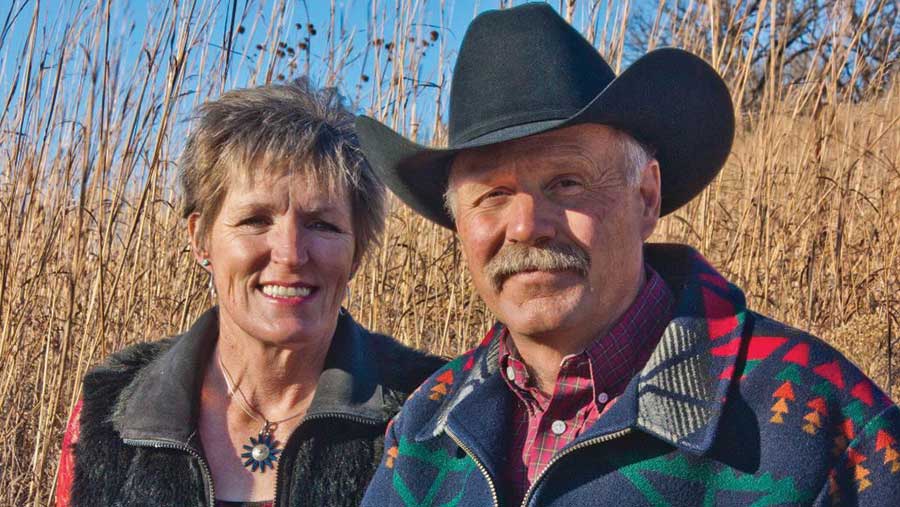
Connie and Joe Mushrush
Autumn calves are now weaned at 160 days following changes made in response to the 2012 drought, which forced herds to wean early. Meanwhile, spring calves are weaned at about 175-200 days, depending on grass availability.
Connie adds: “Spring fits us better but we do fall calving because many customers like older bulls, although this calving block is costly as these cows are supplemented more during lactation and breeding.”
The Mushrush cows are smaller than the national average, but Daniel points to extensive US research showing that bigger cows don’t necessarily wean bigger calves and that milk EPDs (estimated progeny difference) are producing excessively milky cows for many US environments.
Bulls for big country
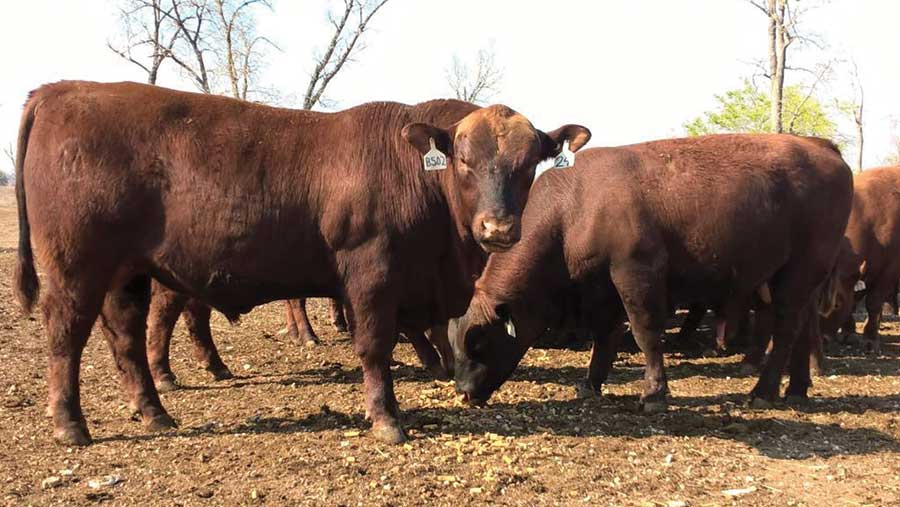 The year’s work culminates in selling 200-head of breeding bulls at the annual ranch sale on the third Friday in March. One bull delivery route requires Daniel to drive yearling and eighteen-month-old bulls 3,000 miles in four days.
The year’s work culminates in selling 200-head of breeding bulls at the annual ranch sale on the third Friday in March. One bull delivery route requires Daniel to drive yearling and eighteen-month-old bulls 3,000 miles in four days.
Good locomotion is paramount for sires working across expansive ranches, explains Daniel. For this reason, bull development pens are located in an abandoned limestone quarry, with the rugged environment promoting strong pasterns and hard feet.
At home in Chase County, Kansas, a cow-calf pair is given eight acres (3.23ha) but Daniel stresses that US cattle country is hugely varied.
“In Missouri, where they have fescue and lots of rain, it may be one or two acres [0.4-0.8ha] a pair. In Nevada it may be 150 acres [60ha] or even more. Our own stocking rates revolve around supplementing with protein and hay through winter months.”
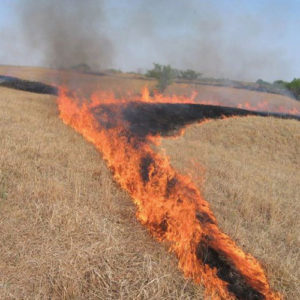 Winter frosts are prolonged in the Flint Hills and temperatures regularly fall to -8C. This requires dead grasses to be burnt off in controlled fires in April, with around 60% of pasture burnt off.
Winter frosts are prolonged in the Flint Hills and temperatures regularly fall to -8C. This requires dead grasses to be burnt off in controlled fires in April, with around 60% of pasture burnt off.
Annual burning fertilises the land, promotes growth when rains come (normally in May and June), helps to control weeds, brush, ticks and parasitic worms and avoids fibrous bunches of unpalatable grass developing, explains Daniel.
Maternal ability and marbling
Two new herd indices have been developed recently by the Red Angus Association of America – HerdBuilder and GridMaster.
- HerdBuilder Index – An indication of a particular sire’s ability to build up profitable herds, rating the ability of daughters to produce replacement heifers and sell progeny on the national quality-based carcass grid from typical Angus-cross progeny. The index is derived from stayability (the ability of a daughter to remain in the herd for at least six years), heifer pregnancy and calving ease.
- GridMaster Index – Rates on progeny performance in feedlots and subsequent carcass on a Red Angus crosses derived from marbling, yield grade and growth EPD.
Mushrush breeding is a balanced programme of terminal and maternal traits, with a focus on commercial buyers.
Attention is therefore put on calving ease, maintenance energy and stayability EPDs, balanced against the marbling and carcass qualities of the Red Angus to suit the demands of the consumer, explains Daniel.
Top Mushrush sires for 2015
|
Sire name |
HerdBuilder |
GridMaster |
|
Mushrush Impressive CA U236 |
157 |
53 |
|
Mushrush Impressive LN X018 |
137 |
52 |
|
Mushrush Impact Z352 |
169 |
52 |
|
Mushrush Triton A330 |
153 |
53 |
|
Mushrush Julian N202 S059 |
141 |
56 |
|
Mushrush Trojan X332 |
171 |
55 |
|
National average (spring 2015 sire summary) |
109 |
50 |
Testing technology
Efficiency doesn’t stop at breeding cattle. Three new pieces of ear tag technology are being deployed across the ranch this spring – EID and radio frequency identification (RFID) – with the aim of driving labour efficiency and management options.
With no equivalent to a British Cattle Movement Service, a cattle’s tag is used entirely for a ranch’s management purposes. Up until this year, visual tags displayed animal and parent ID – but Daniel explains this is changing.
- EID tags – Tracking all measurable pedigree information at every life event.
- Cattletraxx RFID – A cattle tracing system via internet and phone lines that relays cow location every 15 seconds to an accuracy of a 16m square or smaller.
- GrowSafe feed bunk – Uses an RFID system to measure feed intake and monitor behaviour. Shown to benefit US producers by £28 a head.
Cattle tracking ear tags run to a gateway system, which can be a farm office computer up to 30 miles away. They run on a battery and solar panels, providing a capability that the Mushrush family have been “dreaming of for years”.
“This will save us hours of the day we spend just looking for cattle,” explains Daniel. “It will alert us if a bull leaves a group of cows via text message – it’s amazing technology.”
In addition to the breeding operation, home-raised heifers supply a meat company and a growing number of animals are slaughtered for the family meat brand.
The feed bunks will be used to measure feed intake down to 0.5g, which is designed to drive savings through optimal marketing, early disease detection, improved management of poorer performers and reduced days on feed.
Daniel believes the technology will hugely improve efficiency in the US cattle industry.
“This way we can calculate exactly their feed-to-gain conversion rates.”
